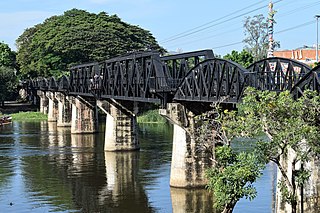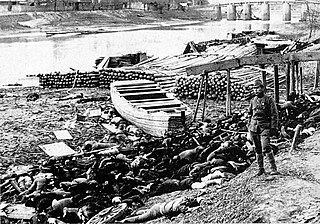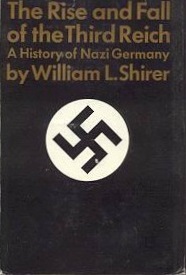
A prisoner of war (POW) is a person who is held captive by a belligerent power during or immediately after an armed conflict. The earliest recorded usage of the phrase "prisoner of war" dates back to 1610.

The Burma Railway, also known as the Siam–Burma Railway, Thai–Burma Railway and similar names, or as the Death Railway, is a 415 km (258 mi) railway between Ban Pong, Thailand, and Thanbyuzayat, Burma. It was built from 1940 to 1943 by civilian laborers impressed or recruited by the Japanese and prisoners of war taken by the Japanese, to supply troops and weapons in the Burma campaign of World War II. It completed the rail link between Bangkok, Thailand, and Rangoon, Burma. The name used by the Japanese Government was Tai–Men Rensetsu Tetsudō (泰緬連接鉄道), which means Thailand-Burma-Link-Railway.

Hellfire Pass is the name of a railway cutting on the former Burma Railway in Thailand which was built with forced labour during the Second World War, in part by Allied prisoners of war. The pass is noted for the harsh conditions and heavy loss of life suffered by its labourers during construction. It was called Hellfire Pass because the sight of emaciated prisoners labouring by burning torchlight resembled a scene from Hell.

The Empire of Japan committed war crimes and crimes against humanity in many Asian-Pacific countries during the period of Japanese imperialism, primarily during the Second Sino-Japanese and Pacific Wars. These incidents have been described as "the Asian Holocaust". Some war crimes were committed by Japanese military personnel during the late 19th century, but most were committed during the first part of the Shōwa era, the name given to the reign of Emperor Hirohito.

The Cowra breakout occurred on 5 August 1944, when 1,104 Japanese prisoners of war attempted to escape from a prisoner of war camp near Cowra, in New South Wales, Australia. It was the largest prison escape of World War II, as well as one of the bloodiest. During the escape and ensuing manhunt, four Australian soldiers and 231 Japanese soldiers were killed or committed suicide. The remaining escapees were re-captured and imprisoned.
During World War II, the Allies committed legally proven war crimes and violations of the laws of war against either civilians or military personnel of the Axis powers. At the end of World War II, many trials of Axis war criminals took place, most famously the Nuremberg Trials and Tokyo Trials. In Europe, these tribunals were set up under the authority of the London Charter, which only considered allegations of war crimes committed by people who acted in the interests of the Axis powers. Some war crimes involving Allied personnel were investigated by the Allied powers and led in some instances to courts-martial. Some incidents alleged by historians to have been crimes under the law of war in operation at the time were, for a variety of reasons, not investigated by the Allied powers during the war, or were investigated but not prosecuted.
Gavan Daws is an American writer, historian and filmmaker residing in Honolulu, Hawaii. He writes about Hawaii, the Pacific, and Asia. He is a retired professor of history at University of Hawaii at Manoa.

Nam Tok Sai Yok Noi is a small town in Sai Yok District, Kanchanaburi Province, Thailand, along the route of the Death Railway linking Thailand with Burma. It is named after Sai Yok Noi Waterfall of Sai Yok National Park. During World War II, the small town was known as Tarsoa or Tarsau.

Agnes Betty Jeffrey, OAM was an Australian writer who wrote about her Second World War nursing experiences in the book White Coolies.

The Selarang Barracks incident, also known as the Barrack Square incident or the Selarang Square Squeeze, was a revolt of British and Australian prisoners-of-war (POWs) interned in a Japanese camp in Changi, Singapore.

Iwahig Prison and Penal Farm in Puerto Princesa, Palawan, Philippines is one of seven operating units of the Bureau of Corrections under the Department of Justice.
Edwin Palmer Hoyt was an American writer who specialized in military history. Until 1958, Hoyt worked in news media, after which he produced non-fiction works.

Before the outbreak of World War II in the Pacific, the island of Borneo was divided into five territories. Four of the territories were in the north and under British control – Sarawak, Brunei, Labuan, an island, and British North Borneo; while the remainder, and bulk, of the island, was under the jurisdiction of the Dutch East Indies.

The Lord John series is a sequence of historical mystery novels and shorter works written by Diana Gabaldon that center on Lord John Grey, a recurring secondary character in the author's Outlander series. Secretly homosexual "in a time when that particular predilection could get one hanged," the character has been called "one of the most complex and interesting" of the hundreds of characters in Gabaldon's Outlander novels. Starting with the 1998 novella Lord John and the Hellfire Club, the Lord John spin-off series currently consists of six novellas and three novels.
John A. Glusman is vice president and editor-in-chief of W. W. Norton and Company, the largest independent, employee-owned publisher in the United States, and the author of Conduct Under Fire: Four American Doctors and Their Fight for Life as Prisoners of the Japanese, 1941-1945.
Cameron Forbes is an Australian journalist and author. Born in Rockhampton in Queensland on 1 September 1938. He worked for The Age as Europe correspondent and became foreign editor of The Age in the early 1980s. In the late 80s, Forbes was posted in Singapore as Asia correspondent. He was also Washington correspondent for The Australian from 1997 to 2000.

This is a bibliographyof works on World War II.
The following events occurred in May 1954:












